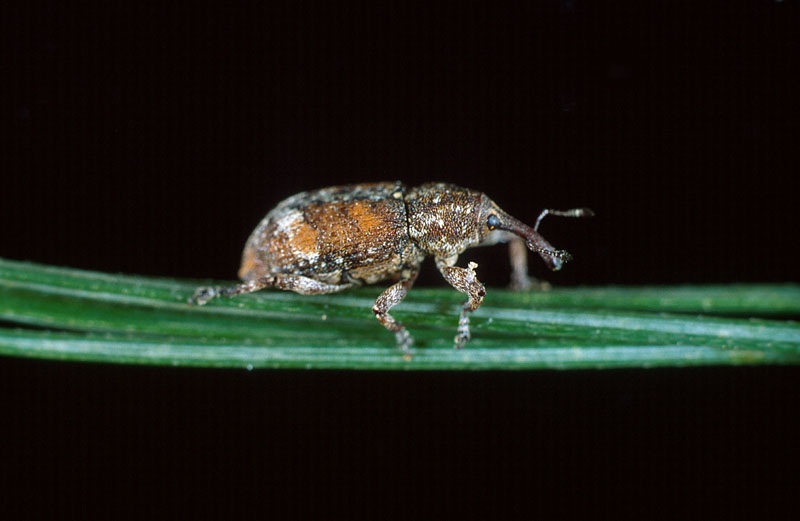This is the final part of a series on spring tree insects. This article examines white pine weevil.
Introduction
In spring, deciduous trees break dormancy, and resume the growing process. During this period, many insects become active, emerging from their overwintering sites to plague their hosts. The following describes some of the insects that may be commonly observed in spring, and how they can impact susceptible trees.
White Pine Weevil (Pissodes strobi)
White pine weevil is an insect that attacks and deforms at least twenty different tree species. The insect is sometimes referred to as spruce weevil in the western United States. White pine weevil is indigenous to North America. Eastern white pine is the insect’s preferred host, though infestations have also been reported on various other pine and spruce trees. White pine weevil poses a serious threat to spruce and pine trees across the United States, and Canada.
Hosts
White pine weevil attacks at least twenty tree species, including eastern white pine, western white pine, Jack pine, Norway spruce, foxtail pine, Japanese pine, limber pine, and Scots pine. Eastern white pine is the most suitable host for insect development. Infestations also occur on Austrian pine, table mountain pine, mugo pine, Jeffrey pine, pitch pine, red pine, black spruce, blue spruce, red spruce, white spruce, and Douglas-fir, albeit with less frequency. White pine weevil is attracted to trees with vigorous leaders that are rooted in open environments. Pine and spruce trees become susceptible to infestation once they have exceeded a height of three feet. Host trees are generally four to twenty feet tall, and at least ½ inch in diameter.
Symptoms of Infestation
In spring, the first visible symptom of infestation is the glistening of resin exuded from the puncture wounds made by the adults on the previous year’s growth. The persistent feeding of the larvae girdles the stem, causing the new shoot to wilt, and the needles to turn reddish-brown. Wilting is most conspicuous in June across the southern part of the insect’s range. In the northern and western part of its range, wilting becomes most apparent in late summer or early fall. Severe infestations often result in extensive foliar dieback. One or more lateral branches may bend, and grow upwards, assuming the terminal role. This causes the tree to become crooked, and malformed. Circular holes around an inch in diameter can be observed in the bark once the adults have emerged.
White pine weevil reduces tree vigor. Tree mortality is rare, but can occur in small trees. Weevil attacks generally reduce tree height growth by 40% to 60%. Stem deformation is common, and may result in the formation of wood defects such as tree forks, compressed wood, and bark knots. The loss in tree vigor renders trees more susceptible to heart rot organisms like Phellinus pini Ames, a serious heart rot disease of older eastern white pines, and invasion from wood decay organisms.
Treatment
- Weevil populations may be limited by the insect’s natural predators. These include a dipteran predator, Lonchaea corticis, and two hymenopteran parasites, Eurytoma pissodis, and Dolichotomitus terabrans nubilipennis. Birds, such as the white-breasted nuthatch, the downy woodbecker, chickadees, grosbeaks, and warblers feed on the larvae and pupae. Small rodents, such as voles, field mice, and shrews destroy adults by hibernating in the litter.
- Maintain tree vigor through sound cultural practices. Ensure that trees are sufficiently watered, especially during extended periods of drought. Apply a layer of organic mulch around the base of vulnerable trees to improve the soil quality, moderate the soil temperature, and retain soil moisture.
- Reduce the potential for infestation by planting susceptible trees in dry locations. Growing pine under a hardwood overstory will reduce the incidence of weevil attacks by slowing the growth of the leader, and reducing sun exposure. This will prevent trees from becoming too vigorous. While this can be detrimental to overall tree growth, it will minimize the dispersal of the adults in fall, and help to stave off the adult females.
- Prune infested terminals and branches before the adults emerge. Pruning cuts should be administered at the first sign of wilting. This will prevent growth loss, and reduce overwintering adult populations.
- When a terminal leader becomes infested, and must be removed, pruning of lateral branches and tree forks can assist the tree in establishing a healthy main stem. When the branches are removed correctly, a stiff rod or stake can be attached to the tree top. A strong lateral branch should be selected, and tied to the rod or stake. Remove competing branches to prevent multiple trunks from forming, and allow the lateral branch to assume the terminal role.
- Banding trees with a sticky substance may deter adults from ascending the trunk. Avoid placing banding materials directly on the bark.
- Chemical treatments can help limit weevil populations, though they are only effective against adults. Treatments can be performed in spring as the adults emerge from hibernation, or in fall as the young adults appear. Applications in spring should thoroughly cover the leader, and upper branches. Adults are especially vulnerable to chemical control in fall when they are feeding on new growth in the upper crown.
Photo courtesy of the Government of Canada


